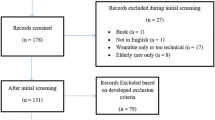Abstract
Nowadays the continuous growing in global population and the related increase of life expectancy lead to explore new ways of making the most of the limited resources humanity has. This endeavor challenges especially the current health care of elderly population, which is particularly associated with a marked prevalence of chronic neurological disorders such as Parkinson’s Disease. Internet of Things and wearable technologies have opened up a new revolution in the domain of healthcare. Minimizing the response time in diagnosis and treatment, Internet of Things thrives towards omnipresence of the healthcare services. Using wearable devices, the lifestyle data is collected from multifarious sources, which is then accumulated, analyzed and acted upon. The emerging technological area of Wearable Sensors and the Internet of Things seems to provide a smart and intelligent way of catering ubiquitous healthcare services to the elderly population, taking healthcare facilities to a higher dimension of omnipresence.

Similar content being viewed by others
References
Parkinson’s UK. Parkinson’s prevalence in the United Kingdom. London, UK; 2012. p. 1–13.
Crawford P, Zimmerman EE. Differentiation and diagnosis of tremor. Am Fam Physician. 2011;1583(6):697–702.
Jankovic J. Parkinson’s disease: clinical features and diagnosis. J Neurol Neurosurg Psychiatry. 2008;79:368–76.
DeLong MR, Wichmann T. Circuits and circuit disorders of the basal ganglia. Arch Neurol. 2007;64(1):20–4.
Darkins AW, Fromkin VA, Benson DF. A characterization of the prosodic loss in Parkinson’s disease. Brain Lang. 1988;34:315–32.
Budzianowska A, Honczarenko K. Assessment of rest tremor in Parkinson’s disease. Pol J Neurol Neurosurg. 2008;42:12–21.
Bacher M, Scholz E, Diener HC. 24 hour continuous tremor quantification based on EMG recording. Electroencephalogr Clin Neurophysiol. 1989;72:176–83.
Rajaraman V, Jack D, Adamovich SV, Hening W, Sage J, Poizner H. A novel quantitative method for 3D measurement of parkinsonian tremor. Clin Neurophysiol. 2000;111:338–43.
Salarian RH, Wider C, Burkhard PR, Vingerhoets FJ, Aminian K. Quantification of tremor and bradykinesia in Parkinson’s disease using a novel ambulatory monitoring system. IEEE Trans Biomed Eng. 2007;54(2):313–22.
Pastorino M, Arredondo MT, Cancela J, S. G. Wearable sensor network for health monitoring: The case of Parkinson’s Disease. J Phys Conf Ser. 2013;450(1):012055.IOP
Pasluosta F, Barth J, Gassner H, Klucken J, Eskofier BM. Pull test estimation in parkinson’s disease patients using wearable sensor technology. 37th Annual International Conference of the IEEE Engineering in Medicine and Biology Society (EMBC), 2015. p. 3109–12.
Foerster F, Smeja M, Fahrenberg J. Detection of posture and motion by accelerometry: a validation study in ambulatory monitoring. Comput Hum Behav. 1999;15:571–83.
Patel S, Hughes R, Huggins N, Standaert D, Growdon J, Dy J, Bonato P. Using wearable sensors to predict the severity of symptoms and motor complications in late stage Parkinson’s disease. In Proc. 30th IEEE Annu. Int Conf Eng Med Biol Soc. Vancouver, BC, Canada; 2008. p. 3686–9.
Patel S, Lorincz K, Hughes R, Huggins N, Growdon J, Standaert D, Akay M, Dy J, Welsh M, Bonato P. Monitoring motor fluctuations in patients with Parkinson’s disease using wearable sensors. IEEE Trans Info Tech Biomed. 2009;13(6):864–73.
Smeja M, Foerster F, Fuchs G, Emmans D, Hornig A, Fahrenberg J. 24–h assessment of tremor activity and posture in Parkinson’s disease by multi-channel accelerometry. J Psychophysiol. 1999;13:245–56.
Lorincz K, Chen BR, Challen GW, Chowdhury AR, Patel S, Bonato P, Welsh M. Mercury: a wearable sensor network platform for high-fidelity motion analysis. Sens Syst. 2009;9:183–96.
Ward JA, Lukowicz P, Troster G, Starner TE. Activity recognition of assembly tasks using body-worn microphones and accelerometers. IEEE Trans Pattern Anal Mach Intell. 2006;28(10):1553–67.
Hoff JI, EA W, BJ v H. Ambulatory objective assessment of tremor in Parkinson’s disease. Clin Neuropharmacol. 2001;24:280–3.
Norman KE, Edwards R, Beuter A. The measurement of tremor using a velocity transducer: comparison to simultaneous recordings using transducers of displacement, acceleration and muscle activity. J Neurosci Methods. 1999;92:41–54.
O’Suilleabhain PE, Matsumoto JY. Time–frequency analysis of tremors. Brain. 1998;121:2127–34.
Rudzinska M, Izworski A, Banaszkiewicz K, Bukowczan S, Marona M, Szczudlik A. Quantitative tremor measurement with the computerized analysis of spiral drawing. Neurol Neurochir Pol. 2007;41:510–6.
Timmer J, Gantert C, Deuschl G, Honerkamp J. Characteristics of hand tremor time series. Biol Cybern. 1993;70:75–80.
van Someren J, Vonk BF, Thijssen WA, Speelman JD, Schuurman PR, Mirmiran M, Swaab DF. A new actigraph for longterm registration of the duration and intensity of tremor and movement. IEEE Trans Biomed Eng. 1998;45(3):386–95.
Zwartjes HT, van Vugt J, Geelen J, Veltink P. Development of a system for measurement and analysis of tremor using a three-axis accelerometer. IEEE Trans Biomed Eng. 2010;57:2779–86.
O’Suilleabhain PE, Dewey Jr RB. Validation for tremor quantification of an electromagnetic tracking device. Mov Disord. 2001;16:265–71.
Riviere N, Reich SG, Thakor NV. Adaptive fourier modeling for quantification of tremor. J Neurosci Methods. 1997;74:77–87.
Cipparrone L, Ginanneschi A, Degl'Innocenti F, Porzio P, Pagnini P, Marini P. Electro-oculographic routine examination in Parkinson's disease. Acta Neurol Scand. 1988;77:6–11. doi:10.1111/j.1600-0404.1988.tb06966.x.
Lane N, Miluzzo E, Lu H, Peebles D, Choudhury T, Campbell A, College D. Adhoc and sensor networks: a survey of mobile phone sensing. IEEE Commun Mag. 2010;140–150
Chatterjee P, Armentano RL. “Internet of things for a smart and ubiquitous eHealth system”, computational intelligence and connected networks (CICN), 2015 seventh international conference on. 2015.
The Michael J. Fox Foundation. Wearable sensors and a web-based application to monitor patients with Parkinson’s disease in the home environment. https://www.michaeljfox.org/foundation/grant-detail.php?grant_id=471
Ganti R, Ye F, Lei H. Mobile crowdsensing: current state and future challenges. IEEE Commun Mag. 2011;49:32–9.
Author information
Authors and Affiliations
Corresponding authors
Ethics declarations
Conflict of interest
The authors declare that they have no conflict of interest.
Funding
There is no funding source.
Ethical approval
This article does not contain any studies with human participants or animals performed by any of the authors.
Additional information
This article is part of the Topical Collection on Health and Technology in Latin America
Rights and permissions
About this article
Cite this article
Romero, L.E., Chatterjee, P. & Armentano, R.L. An IoT approach for integration of computational intelligence and wearable sensors for Parkinson’s disease diagnosis and monitoring. Health Technol. 6, 167–172 (2016). https://doi.org/10.1007/s12553-016-0148-0
Received:
Accepted:
Published:
Issue Date:
DOI: https://doi.org/10.1007/s12553-016-0148-0




